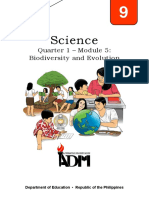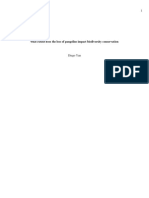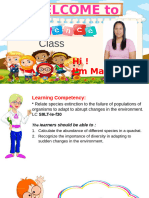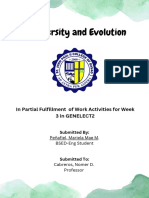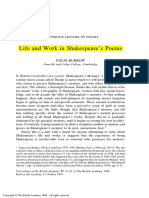LionfishInvasion-CaseStudies-CL (1) Rayan Merie
LionfishInvasion-CaseStudies-CL (1) Rayan Merie
Uploaded by
Reno MmCopyright:
Available Formats
LionfishInvasion-CaseStudies-CL (1) Rayan Merie
LionfishInvasion-CaseStudies-CL (1) Rayan Merie
Uploaded by
Reno MmOriginal Title
Copyright
Available Formats
Share this document
Did you find this document useful?
Is this content inappropriate?
Copyright:
Available Formats
LionfishInvasion-CaseStudies-CL (1) Rayan Merie
LionfishInvasion-CaseStudies-CL (1) Rayan Merie
Uploaded by
Reno MmCopyright:
Available Formats
Lionfish Invasion:
Density-Dependent Population Dynamics Click & Learn
Case Study Handouts
CASE STUDY 1: Fruit production in paprika peppers
Paprika pepper (Capsicum annuum var. annuum L.) is a plant that is commonly grown for its fruits, which are
dried and ground up to make the spice paprika. Cavero and colleagues (2001) wanted to know what factors
affect a pepper plant’s yield, which is the total dry weight of the fruits it produces. A plant’s fruit yield is a
measure of the reproductive output of an individual.
The scientists planted paprika pepper seeds and let them grow for one month. They then removed some of the
plants to create 10 groups with different densities, which ranged from 13,333 plants per 10,000 m2 to 533,333
plants per 10,000 m2. Six months later, the scientists picked the fruits from a small section of each group. The
fruits were counted, dried, and weighed to determine the fruit yield per plant — as well as the overall yield of all
plants within 10,000 m2 — for each of the 10 groups.
The effect of density on the yield (total dry weight of the fruit produced) of pepper plants over one year. Each
point represents the mean of four replicates at a given density. The error bars show ±1 standard deviation.
1. Describe the relationship between plant density and the yield per plant.
2. Predict how the yield per plant (fruit production) might affect the population growth rate.
3. What pepper plant density would you recommend to a farmer to maximize the yield per 10,000 m2? Why
did you choose that density?
www.BioInteractive.org Published October 2020
Page 1 of 5
Click & Learn
Lionfish Invasion: Density Dependent Population Dynamics Case Study Handouts
CASE STUDY 2: Population growth rates of protozoa
This study investigated population dynamics in Colpidium protozoa, single-celled organisms that live in
freshwater environments and eat bacteria. Holdridge and colleagues (2016) grew groups of protozoa at four
different initial densities. After three days, they measured the final densities to calculate the realized per capita
population growth rate (rrealized) for each group.
The scientists also wanted to know how the population growth rate at a given density is affected by resource
availability. So, they studied the four densities of protozoa under two different conditions: high and low
resource availability. Protozoa under the “high resource availability” condition got about four times as much
food (bacteria that grew on dried bloodworms) as protozoa under the “low resource availability” condition did.
The effect of initial density and resource (food) availability on the realized per capita population growth rate
(rrealized) of Colpidium protozoa. rrealized was calculated by subtracting the initial cell density from the final cell
density, then dividing that difference by the initial cell density.
1. Use evidence from the graphs to make a claim about how rrealized is affected by the initial population density.
In other words, how does rrealized differ between populations that start small and those that start big?
2. Use evidence from the graphs to make a claim about how resource availability affects rrealized.
www.BioInteractive.org Published October 2020
Page 2 of 5
Click & Learn
Lionfish Invasion: Density Dependent Population Dynamics Case Study Handouts
CASE STUDY 3: Parasites on fish farms
Many fish eaten as seafood are bred and raised in fish farms. The fish on a farm can be infected by parasites
called sea lice: small crustaceans that feed on a fish’s blood and skin, which may injure or even kill the fish.
Jansen and colleagues (2012) analyzed sea lice infections on trout and salmon farms. They used data reported
by many fish farms on the numbers of sea lice found on their fish. The scientists compared the number of sea
lice with the “local farmed fish biomass density,” which is a measure of population density that accounts for
both the number and biomass (or size) of fish on a farm.
The effect of local farmed fish biomass density on the counts (numbers) of sea lice per fish. Each point represents
the mean fish density and sea lice count for a group of farms in a specific year.
1. How does density of fish on a farm affect the number of sea lice per fish?
2. Other research reported a link between sea lice infestation and mortality. If that is the case here, what do
you predict will happen to high-density fish populations?
3. How might the results of Jansen et al. (2012) impact policies about fish farming — in particular, the size of
fish farms?
www.BioInteractive.org Published October 2020
Page 3 of 5
Click & Learn
Lionfish Invasion: Density Dependent Population Dynamics Case Study Handouts
Case study 4: Cannibalism in shore crabs
The shore crab is a common crab species found all over the world. These crabs are cannibals that will eat
younger, smaller individuals even when other food sources are available. Certain factors make the crabs more
likely to eat each other.
To investigate these factors, Dr. Per-Olav Moksnes (2004) set up tanks with different densities of young, small
shore crabs. He then added two older, larger crabs to each tank. After 24 hours, he determined how many of the
young crabs had been eaten by the older crabs (the “cannibal crabs”).
The effect of density (number of young crabs per m2) on the number of young crabs that are eaten per cannibal
crab within 24 hours. Each point represents a mean of five trials at the corresponding density. The error bars show
±1 standard error.
1. Describe the pattern shown in the figure.
2. As density increases, how might changes in the frequency of cannibalism affect the population growth rate?
3. Although the cannibal crabs in this study had another food source, they did not eat all of it during the
experiment. This result suggests that cannibalism was not a response to starvation. How else might these
crabs benefit from cannibalism?
www.BioInteractive.org Published October 2020
Page 4 of 5
Click & Learn
Lionfish Invasion: Density Dependent Population Dynamics Case Study Handouts
Case study 5: Predation of mosquito larvae
Young mosquitoes, called larvae, are small, wormlike, and live in the water. They are eaten by a variety of
predators, including a species of small fish called the banded killifish (Fundulus diaphanus). Bickerton and
colleagues (2018) used killifish and mosquito larvae to investigate factors that affect predation. The scientists
placed pairs of killifish in tanks with mosquito (Culex pipiens) larvae at five different densities. They then used
digital images to record how many larvae were eaten by the killifish over time.
The effect of density (number of mosquito larvae per predator) on the number of larvae consumed by killifish after
1.5 hours.
1. How did the number of mosquito larvae killed by predators change as the density of larvae increased?
2. Based on your answer to the previous question, how might the mosquito population growth rate change as
the density of mosquito larvae increases?
www.BioInteractive.org Published October 2020
Page 5 of 5
You might also like
- HHMI Ants To GrizzliesDocument4 pagesHHMI Ants To Grizzliessofiagarris714No ratings yet
- Discussion (Bernoulli Theorem)Document2 pagesDiscussion (Bernoulli Theorem)Uztaz Dol Keke83% (23)
- SBI4U Unit 5 Practice Test AnswersDocument6 pagesSBI4U Unit 5 Practice Test AnswersAreebaNo ratings yet
- IB Biology Extended Essay - A ScoringDocument36 pagesIB Biology Extended Essay - A ScoringCaitlinNo ratings yet
- QSK60 G4 PDFDocument2 pagesQSK60 G4 PDFLuki100% (2)
- Important Notice: Use and CareDocument16 pagesImportant Notice: Use and Carejrem.ypNo ratings yet
- BY DR Jahangir Hammad BDS, FcpsDocument110 pagesBY DR Jahangir Hammad BDS, FcpsAtika Iftikhar MirNo ratings yet
- Chapter 5: Interactions in The Ecosystem: 5.1 Habitats and Niches 5.2 Evolution and Adaptation 5.3 PopulationsDocument49 pagesChapter 5: Interactions in The Ecosystem: 5.1 Habitats and Niches 5.2 Evolution and Adaptation 5.3 PopulationsJan Marlon GoritNo ratings yet
- Saeed Abdinur - Niche Partioning and DNA Metabarcoding LabDocument5 pagesSaeed Abdinur - Niche Partioning and DNA Metabarcoding Labsaeedabdinur1245No ratings yet
- Demonstratio N Teaching: Classroom Observation 1Document33 pagesDemonstratio N Teaching: Classroom Observation 1Redante PolicarpioNo ratings yet
- Chapter 5 Student Edition FullDocument24 pagesChapter 5 Student Edition FullSergio Andrés RodríguezNo ratings yet
- Lesson 4B Limiting FactorsDocument24 pagesLesson 4B Limiting FactorsMelody Dignos100% (1)
- ORGANISMS AND POPULATIONS - NewDocument8 pagesORGANISMS AND POPULATIONS - Newkrishverma1304No ratings yet
- Biodiversity 13-Mar-2022Document5 pagesBiodiversity 13-Mar-2022olimjonuvayzov6807No ratings yet
- 2020 05 07 051037v2 FullDocument35 pages2020 05 07 051037v2 Fullcristian santillanNo ratings yet
- Population EcologyDocument22 pagesPopulation EcologyKyla BrillanteNo ratings yet
- ActivityAntsGrizzlies StudentHO Act ORIGINALDocument5 pagesActivityAntsGrizzlies StudentHO Act ORIGINALblawler.f24No ratings yet
- Science 9 Week 5 Quarter 1Document24 pagesScience 9 Week 5 Quarter 1L.J. Santos100% (2)
- Carrying Capacity and Limiting FactorsDocument20 pagesCarrying Capacity and Limiting FactorsJas Lyn Claire100% (1)
- 2 Writing PDFDocument22 pages2 Writing PDFJaffery143100% (1)
- Science-9 q1 w5 Mod5 AdmDocument19 pagesScience-9 q1 w5 Mod5 AdmMönica Masangkây100% (1)
- Delhi Technological University: Project ReportDocument21 pagesDelhi Technological University: Project Report2K2O-A17-11 Vishal GuptaNo ratings yet
- D P D P A P R: WWW Utahcbcp ORGDocument4 pagesD P D P A P R: WWW Utahcbcp ORGslupisNo ratings yet
- Wood Duck Nest Survival and Duckling Recruitment IDocument16 pagesWood Duck Nest Survival and Duckling Recruitment Itranquilitylb412No ratings yet
- Julie ManuscriptDocument46 pagesJulie ManuscriptAniana CalizNo ratings yet
- EARTHLIFE SCIENCE Q2 Week 8 Edited 1 11.pdf Version 1Document11 pagesEARTHLIFE SCIENCE Q2 Week 8 Edited 1 11.pdf Version 1Princess Nicole Manoguid100% (1)
- SWT + EssayDocument22 pagesSWT + EssayEl hussein SayedNo ratings yet
- BabaDocument5 pagesBabayanyijia2027No ratings yet
- Science 9 Q1melc 4 Population DensityDocument96 pagesScience 9 Q1melc 4 Population DensityMenchie YabaNo ratings yet
- Newtsletter 46 2010Document10 pagesNewtsletter 46 2010Sussex Amphibian & Reptile GroupNo ratings yet
- Explain The Relationship Between Population Growth and Carrying Capacity. 2. Suggest Ways To Minimize Human Impact On The EnvironmentDocument5 pagesExplain The Relationship Between Population Growth and Carrying Capacity. 2. Suggest Ways To Minimize Human Impact On The EnvironmentJaneth Miguel SatrainNo ratings yet
- AnnotatedbibliographyDocument2 pagesAnnotatedbibliographyapi-339257505No ratings yet
- Diversity 14 00748Document15 pagesDiversity 14 00748Adenia Izzatul MahmulahNo ratings yet
- Heij Willenborg 2020 Carabids Biocontrollers BioSciDocument11 pagesHeij Willenborg 2020 Carabids Biocontrollers BioSciAnahi PavonNo ratings yet
- Bio AccumulationDocument24 pagesBio AccumulationMRMFARAHNo ratings yet
- Ethology - 2019 - GoymannDocument9 pagesEthology - 2019 - GoymanntherealosaisNo ratings yet
- White Paper About Carnivourous Plants After Editing-1Document9 pagesWhite Paper About Carnivourous Plants After Editing-1api-709797972No ratings yet
- Bio ProjectDocument15 pagesBio Projectlucky20080802No ratings yet
- LAS 7 SCIENCE 10 BS 3 Samaniego LeisethDocument6 pagesLAS 7 SCIENCE 10 BS 3 Samaniego LeisethGail MoraNo ratings yet
- For Defense Thesis JudyDocument19 pagesFor Defense Thesis JudyFULGENCIO, ROSHELLENo ratings yet
- Peñafiel Mariela Mae Genelect 2 Week 3Document4 pagesPeñafiel Mariela Mae Genelect 2 Week 3Mariela Mae Magparoc PeñafielNo ratings yet
- SCIENCE 9 - Q1 - W5 - Mod5 - ADMDocument22 pagesSCIENCE 9 - Q1 - W5 - Mod5 - ADMdonnaNo ratings yet
- Alcock 1982 PDFDocument17 pagesAlcock 1982 PDFheimat66No ratings yet
- 12 Passage 2 - Biodiversity Q14-26Document5 pages12 Passage 2 - Biodiversity Q14-26Cương Nguyễn DuyNo ratings yet
- Env and Ecology Test 2Document10 pagesEnv and Ecology Test 2mahinsagotra18No ratings yet
- Yo, Theo BioDocument3 pagesYo, Theo BioAbdelaziz N. MaldisaNo ratings yet
- 12 Passage 2 - Biodiversity Q14-26Document5 pages12 Passage 2 - Biodiversity Q14-26thảo bùiNo ratings yet
- Acob PrevalenceDocument13 pagesAcob Prevalencejoyhairasiano9No ratings yet
- Chapt17 LectureDocument32 pagesChapt17 Lectureareejali8545No ratings yet
- Intro BiodiversityDocument70 pagesIntro Biodiversitylevie agacerNo ratings yet
- Literature ReviewDocument3 pagesLiterature Reviewapi-246228229No ratings yet
- Unit 5 - Activity 1 - Population Growth and Affects WorksheetDocument2 pagesUnit 5 - Activity 1 - Population Growth and Affects WorksheetThin HtetNo ratings yet
- imDocument15 pagesimlokiavenger17No ratings yet
- Biology Unit 2 Module 2 Biodiversity NotesDocument8 pagesBiology Unit 2 Module 2 Biodiversity NotescrystalNo ratings yet
- American J Primatol - 2019 - Norconk - Reducing The Primate Pet Trade Actions For PrimatologistsDocument9 pagesAmerican J Primatol - 2019 - Norconk - Reducing The Primate Pet Trade Actions For Primatologistsfajra hayatiNo ratings yet
- Env200 Chap 2 Community Ecology and Population EcologyDocument21 pagesEnv200 Chap 2 Community Ecology and Population EcologyAli AhmarNo ratings yet
- Prioritizing nationally endemic species for conservationDocument15 pagesPrioritizing nationally endemic species for conservationitsserinalolNo ratings yet
- Acknowledgement 2Document12 pagesAcknowledgement 2Nur Wahidah Md Redzuan50% (2)
- BIODIVERSITYDocument7 pagesBIODIVERSITYEdgar HernándezNo ratings yet
- 12-1 Community InteractionsDocument11 pages12-1 Community Interactionsapi-265907602No ratings yet
- Insect Biodiversity Survey - Science WorldDocument4 pagesInsect Biodiversity Survey - Science WorldtgardinerNo ratings yet
- Species Diversity and Spatial Structure of Intertidal Mollusks in Padada, Davao Del Sur, PhilippinesDocument10 pagesSpecies Diversity and Spatial Structure of Intertidal Mollusks in Padada, Davao Del Sur, PhilippinesCharlie Magne H. DonggonNo ratings yet
- BIOL 2406 - Lab Review - Sp22 PDFDocument12 pagesBIOL 2406 - Lab Review - Sp22 PDFM ArNo ratings yet
- Conservation by Proxy: Indicator, Umbrella, Keystone, Flagship, and Other Surrogate SpeciesFrom EverandConservation by Proxy: Indicator, Umbrella, Keystone, Flagship, and Other Surrogate SpeciesNo ratings yet
- Week 19 GR 9 MSCDocument25 pagesWeek 19 GR 9 MSCReno MmNo ratings yet
- MSC GR 9 Week 22Document25 pagesMSC GR 9 Week 22Reno MmNo ratings yet
- GR 9 Week 24 MSCDocument23 pagesGR 9 Week 24 MSCReno MmNo ratings yet
- MSC GR 9 Week 20Document14 pagesMSC GR 9 Week 20Reno MmNo ratings yet
- I 307810187Document1 pageI 307810187Reno MmNo ratings yet
- Why Use Solar Rooftop System - Mahindra SolarizeDocument6 pagesWhy Use Solar Rooftop System - Mahindra SolarizeAsmita SinghNo ratings yet
- The Tiv of NigeriaDocument5 pagesThe Tiv of NigeriaErnestOnyinyechiIheanyichukwuNo ratings yet
- Automatic Sprinkler Control SystemDocument27 pagesAutomatic Sprinkler Control SystemYayati Pathak80% (5)
- WTR ALL Standard Drawings - 202201041256102187Document23 pagesWTR ALL Standard Drawings - 202201041256102187Stela GallarNo ratings yet
- Additive Mfg. Tech. (3D Printing)_CTS2.0_NSQF-3Document42 pagesAdditive Mfg. Tech. (3D Printing)_CTS2.0_NSQF-3Vinod kumar BhargavNo ratings yet
- Science of The Total Environment: Contents Lists Available atDocument16 pagesScience of The Total Environment: Contents Lists Available atMehedi KhannaNo ratings yet
- Architectural Design 1Document30 pagesArchitectural Design 1Anshe ObispoNo ratings yet
- Rohingya CrisisDocument10 pagesRohingya Crisisshoyeb ahmedNo ratings yet
- Life and Work in Shakespeare's PoemsDocument36 pagesLife and Work in Shakespeare's PoemsshivnairNo ratings yet
- Chapter3-Io OrganizationDocument77 pagesChapter3-Io OrganizationPUNITH KUMAR VM100% (1)
- Analyzing The Innovative Challenges and Possible Solutions of Polymer and Related Material Based On AI Chatbot (Chat GPT) ResponsesDocument7 pagesAnalyzing The Innovative Challenges and Possible Solutions of Polymer and Related Material Based On AI Chatbot (Chat GPT) ResponsesInternational Journal of Innovative Science and Research TechnologyNo ratings yet
- Genetics Powerpoint JPDocument31 pagesGenetics Powerpoint JPm w100% (1)
- Brgy. Quezon Liloan Bridge Final Geotechnical Evaluation ReportDocument7 pagesBrgy. Quezon Liloan Bridge Final Geotechnical Evaluation ReportCleth Hiren SantosNo ratings yet
- Level 1 Tracking SheetDocument7 pagesLevel 1 Tracking Sheetangel angelitoNo ratings yet
- Mit Math Thesis DefenseDocument8 pagesMit Math Thesis Defensetiarichardsonlittlerock100% (2)
- ND PreDocument23 pagesND PrejohnNo ratings yet
- Itemspring Codigosap GerenciaDocument37 pagesItemspring Codigosap GerenciaLuis ValenciaNo ratings yet
- Photobucket - Index of CollectionsDocument19 pagesPhotobucket - Index of CollectionsRobert CathcartNo ratings yet
- GrammarDocument32 pagesGrammarAndres MinguezaNo ratings yet
- By: Sir Umair Rasheed: The University of LahoreDocument41 pagesBy: Sir Umair Rasheed: The University of LahoreSuman AgarwalNo ratings yet
- After Activity: Civic Welfare Training Service (CWTS)Document11 pagesAfter Activity: Civic Welfare Training Service (CWTS)Anne Llamera TabanNo ratings yet
- Classification of VyadhiDocument12 pagesClassification of Vyadhiashish PANTNo ratings yet
- Falcon Mark IIDocument4 pagesFalcon Mark IIWoodrow FoxNo ratings yet
- Elitmus All QuestionDocument11 pagesElitmus All QuestionAshish PargainNo ratings yet
- Clinical Diagnosis of Pregnancy: Dr. Archana Vikram Asst ProfDocument24 pagesClinical Diagnosis of Pregnancy: Dr. Archana Vikram Asst ProfMaizura Syahirah Mohtada100% (1)
- Aavin Internship 1Document52 pagesAavin Internship 1Godwin CbNo ratings yet




















